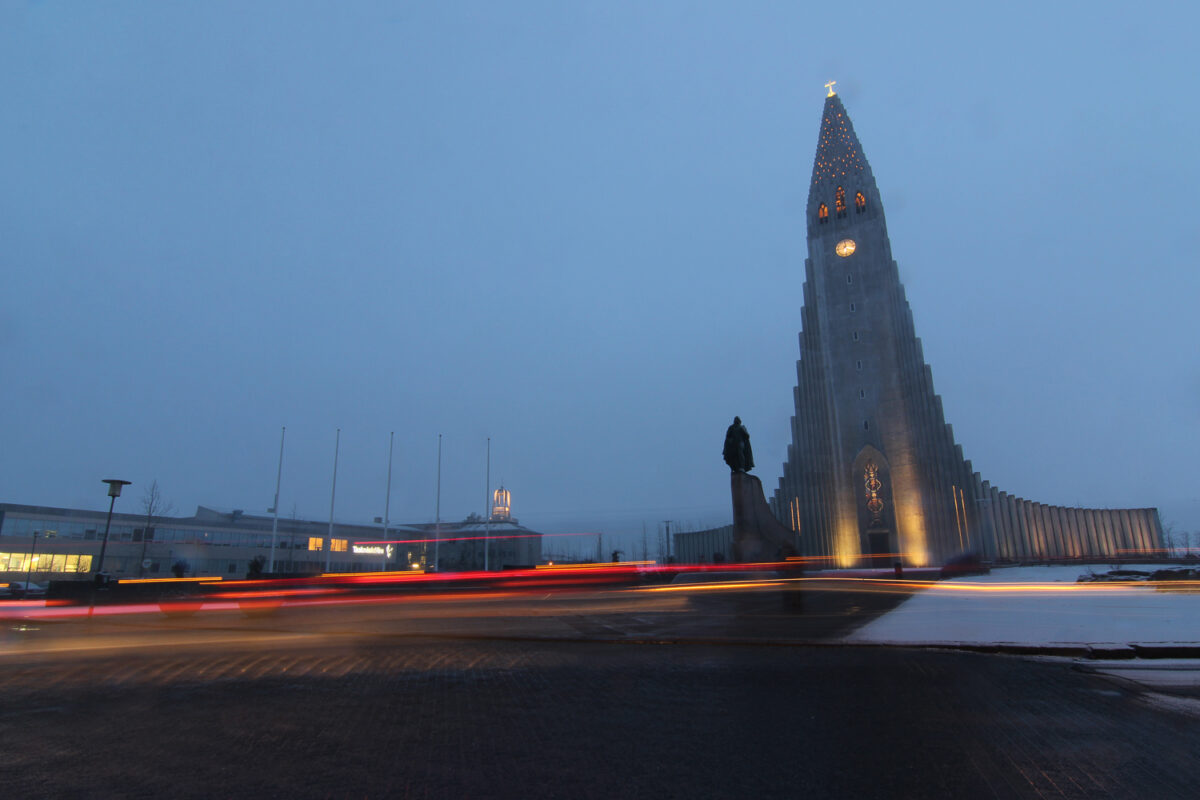ITINERARY
Traveling in February meant driving in tough winter conditions. As novice drivers in the snow, we looked for tours that handled the transportation and offered both activities and stops at all of the best natural wonders. With Reykjavík as our base, we took a couple of tours to explore the southern part of Iceland and spent the rest of the time in the city.
DAY 1: REYKJAVÍK
Arrive in Reykjavík. Walk around the town. Visit Sun Voyager, Harpa Concert Hall, and Hallgrimskirkja. In the evening, try the Icelandic tasting menu at Sjávargrillið.
DAY 2: SELJALANDSFOSS, SKÓGAFOSS & VIK
Take a 3-day tour from Reykjavík to Hofn. En-route stop to admire the Seljalandsfoss & Skógafoss waterfalls. Later visit the Black Sand Beach in Vik. At night search the sky for the elusive Northern Lights.
DAY 3: ICE CAVES IN VATNAJÖKULL
Drive up to the Crystal glacier ice caves. Spend a few hours exploring the labyrinth of rooms, tunnels, and arches underneath the glacier. In the evening, visit the nearby cultural museum or go looking for Icelandic horses. Later, get the cameras ready for another night of the Northern Lights.
DAY 4: DIAMOND BEACH, JÖKULSÁRLÓN AND GLACIER HIKE
On the last day of the tour stop to photograph large glacier ice blocks on the black sand beach. Walk up to Jökulsárlón to see floating ice blocks’ slow journey to the ocean. Later, put on the crampons for a glacier hike in Svínafellsjökull.
DAY 5: REYKJAVÍK & WHALE WATCHING
In the morning, explore Reykjavík downtown. Ride the elevator to the top of Hallgrimskirkja for 360 views of the city. In the afternoon, board a boat for Whale watching tours. Relax in the evening with drinks and dinner.
DAY 6: GOLDEN CIRCLE TOUR
Join the popular Golden Circle tour. Start with the namesake Golden falls (Gullfoss), then visit Haukadalur to watch geyser eruptions, and end the tour at Þingvellir to observe the continental drift. In the evening relish a gourmet meal at the revolving restaurant – Perlan.
DAY 7: VOLCANO FLIGHT OVER HOLUHRAUN
Spend the morning shopping in Reykjavík downtown. When the weather clears up take the flight to Holuhraun to see volcano eruptions. Later in the night join the locals on a rúntur, a weekend tradition involving drinks at multiple bars.
DAY 8: BLUE LAGOON & BACK HOME
End the trip with a geothermal spa at the famous Blue Lagoon. Later, check-in at the airport and fly back home.
Reykjavík is the capital and the largest city of Iceland. It is the economic, political and tourist center and nearly half of the country’s population lives in the city. Reykjavík is also believed to be the site of the first permanent settlement in Iceland.
DAY 1: REYKJAVÍK
We flew in on a red eye from New York and arrived in Reykjavík early in the morning. After immigration, we took the hotel transfer into Reykjavík, which dropped us at our hotel – Hótel Frón. The hotel is right in the city center and close to all of the major attractions.
Our first Icelandic experience was the hot shower at the hotel. The water is geothermally heated and smells of sulphur. It caught us by surprise. At first we thought that there was something wrong with the plumbing, but after a week of stay in Iceland we barely noticed the smell.
Reykjavík downtown is very walkable with most restaurants and bars packed in a 3-5 block radius. After a quick bite at the Sandholt Bakery we headed to the Sun Voyager. Along the way, we had our second Icelandic experience, the quick weather change. The clouds from the bay swept in and it soon started to flurry. In Iceland sudden weather changes are commonplace and there’s a popular saying – “If you don’t like the weather, just wait five minutes”. This is something we would experience throughout the entire trip and the expression can be found everywhere from t-shirts to mugs and on many other types of souvenirs.
Sun Voyager is a large, boat shaped sculpture made of stainless steel that rests on top of a circular base of granite slabs. It is located right by the bay and is surrounded by concrete stairs, which makes it a great place to watch the sunset. But today was definitely not the day for that with all of the cloud coverage.
As the flurries became bigger we headed back towards the city, eagerly looking for refuge. We came across the nearby Harpa Concert Hall and from its beautiful exterior, we knew we had to stop inside.
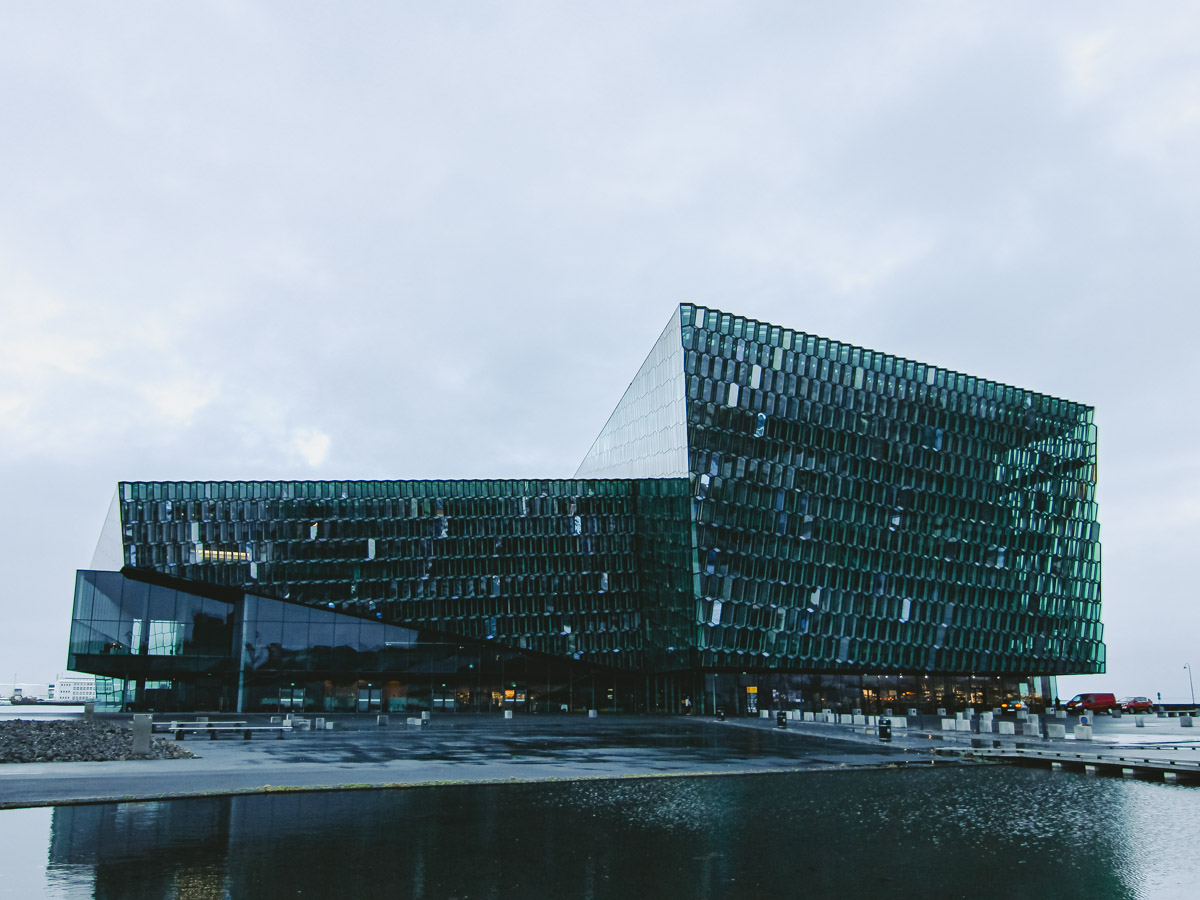
Harpa is a distinctive glass building with a geometric steel frame. Architect Olafur Eliasson attributes the inspiration for the building to the hexagonal basalt columns found throughout Iceland.
From there, we continued back to the main town, pausing briefly at the almost frozen Lake Tjörnin to admire all the swans and ducks swimming in the freezing water. As we left the lake we were drawn to Hallgrimskirkja church, the tallest building in Reykjavík and a landmark visible from almost every part of the city. When we neared the building we could see it was also inspired by Icelandic nature, with the wings of the church modelled after basalt cliffs, gradually rising up to the steeple. It has a fairly unique shape for a church, much taller and narrower, with a pointy top, almost like a spaceship about to take off into the sky. Right in front of Hallgrimskirkja is a very heroic looking statue of Leif Erikson, staring off into the distance. He is believed to be the first European to reach continental North America, far before Christopher Columbus.
As the snow started to pile up, we took our last photos and walked over to Sjávargrillið for dinner. While eating out in Iceland is generally expensive we had to try out the local delicacies. We opted for the Icelandic tasting menu which had bites of whale, puffin, and other seafood varieties. While we didn’t order them, other unique things to try in Iceland are the Ram’s testicles and Sheep’s head. After a delicious meal and a couple of tasty cocktails we called it a night.
Southern Iceland is probably the most popular tourist route and provides easy access to a number of natural attractions including waterfalls, glaciers, ice caves, volcanic beaches and geysers.
DAY 2: SELJALANDSFOSS, SKÓGAFOSS & VIK
When we woke up it was still snowing, all the streets were blanketed in white powder. We were packed and ready to head off on a 3-day tour of Southern Iceland with Extreme Iceland. Winter in Iceland is brutal, it’s cold and icy, accompanied by frequent blizzards. With limited experience driving in these conditions, we opted for a small group tour organized by locals who not only handled all the transportation but also provided guided excursions such as glacier hikes and visits to the ice caves.
As we left the colorful houses of Reykjavík behind we were greeted with vast open landscapes of the country, covered in snow as far as we could see.
Outside the city our first tour stop was Seljalandsfoss. This is a popular stop and anyone who has searched for photos of Iceland will have come across this waterfall – it’s commonly shot from behind the falls where you can see the water streaming over the cliffs edge above your head into the pool below. This vantage point can be risky to get to in the winters as there is a lot of ice on the trail, plus there’d be no hiding from the extremely cold mist of the fall, so instead we opted for the view from the front of the falls.
Not far from Seljalandsfoss is another popular stop, Skógafoss. This waterfall is not only popular with tourists but also with Hollywood and Bollywood directors. While the same height as Seljalandsfoss, Skógafoss feels much bigger. You can walk right up to the foot of the falls and admire its full height, as long as you don’t mind being in the mist zone. After taking in the view from the ground, we started for the upper viewpoint to see the falls from above. Mid-way up the steps we were hit by a blizzard, making the small hike somewhat treacherous because of the slippery steps. Slowly but surely, we continued upward and finally reached the top. All of a sudden the fierce storm was replaced by calm gentle winds and the sun peeked out from behind the clouds. If only we had waited 5 more minutes before starting the hike!
After a short 45 minute ride we arrived at the Black Sand Beach, near Vik – Reynisfjara. Ranked as one of the best non-tropical beaches, Reynisfjara offers panoramic views with the Dyrhólaey rock arch in the west and Reynisdrangar, a series of rocks, in the east. As tempting as it may be, the beach is less than ideal for swimming as frigid violent sneaker-waves break close to the shore. We were caught in one of these sneaker-waves leaving our bottoms and shoes completely wet.
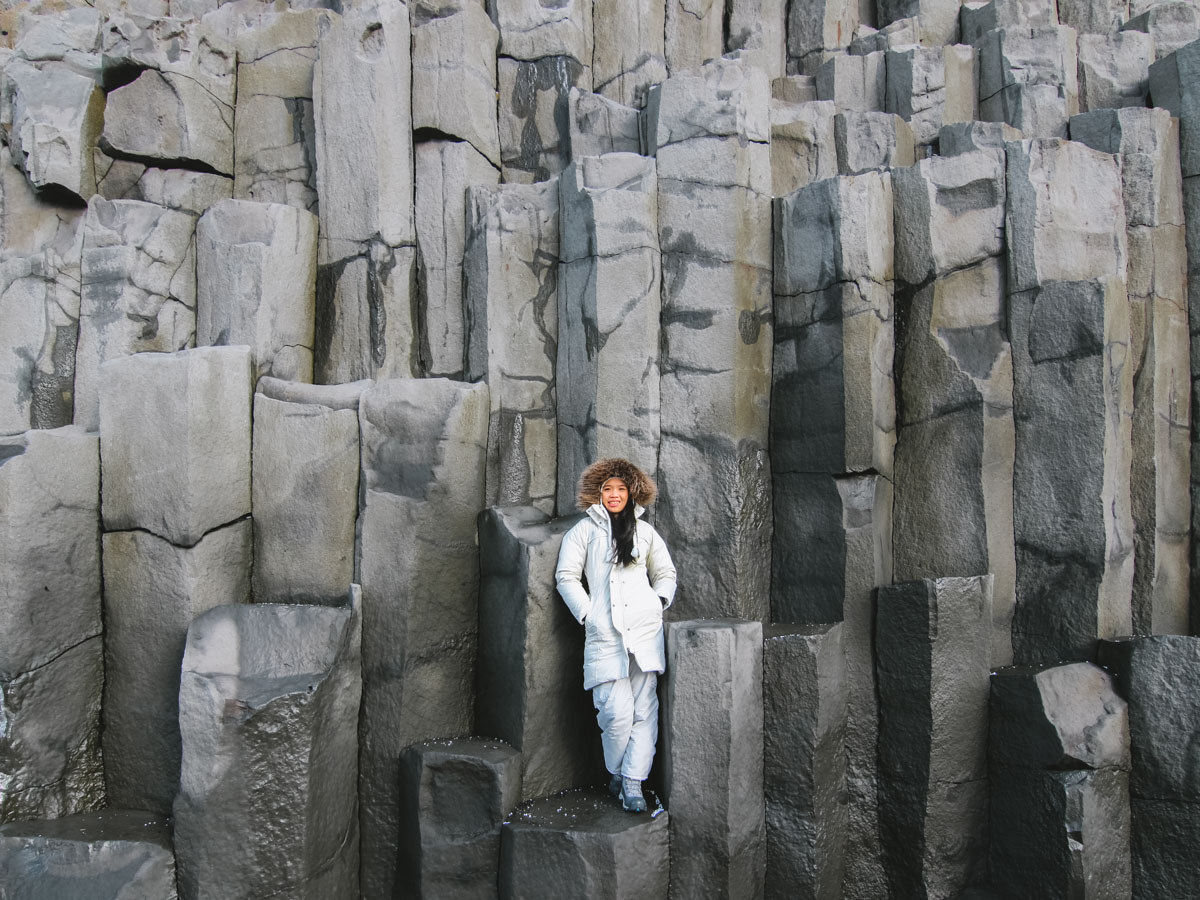
Our favorite part of the beach was the basalt rocks, a picturesque series of hexagonal columns rising from the black volcanic sand like a castle, reminiscent of the architecture at both Harpa Concert Hall and Hallgrimskirkja. Standing on these columns we not only avoided getting more water on our shoes but also got a much better glimpse of the violent waves crashing into the Reynisdrangar sea rocks. And of course just before we left the beach it snowed once more, this time leaving small white pearls of ice along the black sand, making for a really stunning contrast.
As the daylight started to fade, we drove to Guesthouse Gerði, our stay for the night and also our best chance to see Northern Lights on the tour. To be lucky enough to see the aurora with your naked eye there needs to be a high enough level of solar activity and of course a clear sky. Many people extend the length of their trip to Iceland to give themselves more chances to see the Northern Lights, and even in a week’s stay we’ve had friends return without any sightings. At dinner we met other guests who hadn’t seen the Northern Lights in over a week because of the cloudy skies. Disheartened by these stories, we left the restaurant thinking we’d turn in for an early night but as we neared our room we spotted a faint streak of green light behind our cottage. At first we thought it was just a cloud lit up by the cottage lights, but as we got further away from the house the faint green light became bigger and brighter, magically appearing and disappearing into the horizon. We couldn’t believe our eyes, it was indeed the Northern Lights! We rushed back to the cottage for our camera and tripod and set it up at the edge of the guest house overlooking the Atlantic Ocean. The long exposure shots we took revealed purple tones in the lights, rarely visible to naked eye. As the night went on, the lights became even brighter, dancing and swirling over our heads. Despite freezing temperatures, neither of us wanted to go inside. We spent 2 hours outside just watching the lights, trying to immortalize the memory in a timelapse, and marveling at how beautiful nature could be.
Back in our bed, we could still see the Northern lights outside the window. We couldn’t believe our luck. The Aurora was the main reason we had traveled to Iceland in the winter and anything in addition to this was a bonus for us.
DAY 3: ICE CAVES IN VATNAJÖKULL
Guesthouse Gerði is conveniently located in the heart of the Vatnajökull region, close to several attractions in the area. One such attraction is the Crystal Glacier Ice Caves. The caves are about 40-45 minutes from the guest house and most of the journey is on dirt roads which were once under the glacier. There is no way we would have found it ourselves.
After a short hike we arrived at what seemed like the “gates” to the glacier. An arched doorway opened up to a large room entirely made of ice, with the bluest ceiling we’ve ever seen arching from one end of the floor to another. Before this we had only seen glaciers in photographs and on TV, so it was a surreal feeling standing right below one, taking it all in. The early morning sun had lit up the entire place, giving it a shimmering crystal glow. One room led to another revealing a maze of tunnels and arches. As we went deeper into the cave, the color of the ice turned bluer, illuminated by the light trapped in the ice. We spent an hour going from one room to another, admiring the different shapes and features of the ice palace – the twists of the frozen water, the trapped bubbles, and all of the interesting textures that gave the space a dynamic look. As we emerged from the caves we were still in awe of the enormous size and scale of these glaciers. It really put in perspective the conversations about global warming and what will happen if these glaciers continue to melt away.
Back at the guesthouse we had the rest of the day to ourselves. There wasn’t a lot to do within walking distance, just a cultural museum and a whole lot of farms. So after a short nap we went out for a stroll, not quite sure where we were headed. The area is very open and quiet, with mountains & glaciers on one side and the Atlantic ocean on the other. It certainly made for a nice late afternoon walk. As we got closer to the farms, we were greeted by the most beautiful Icelandic horses. Watching us approach the fence, these gentle creatures walked over to us.
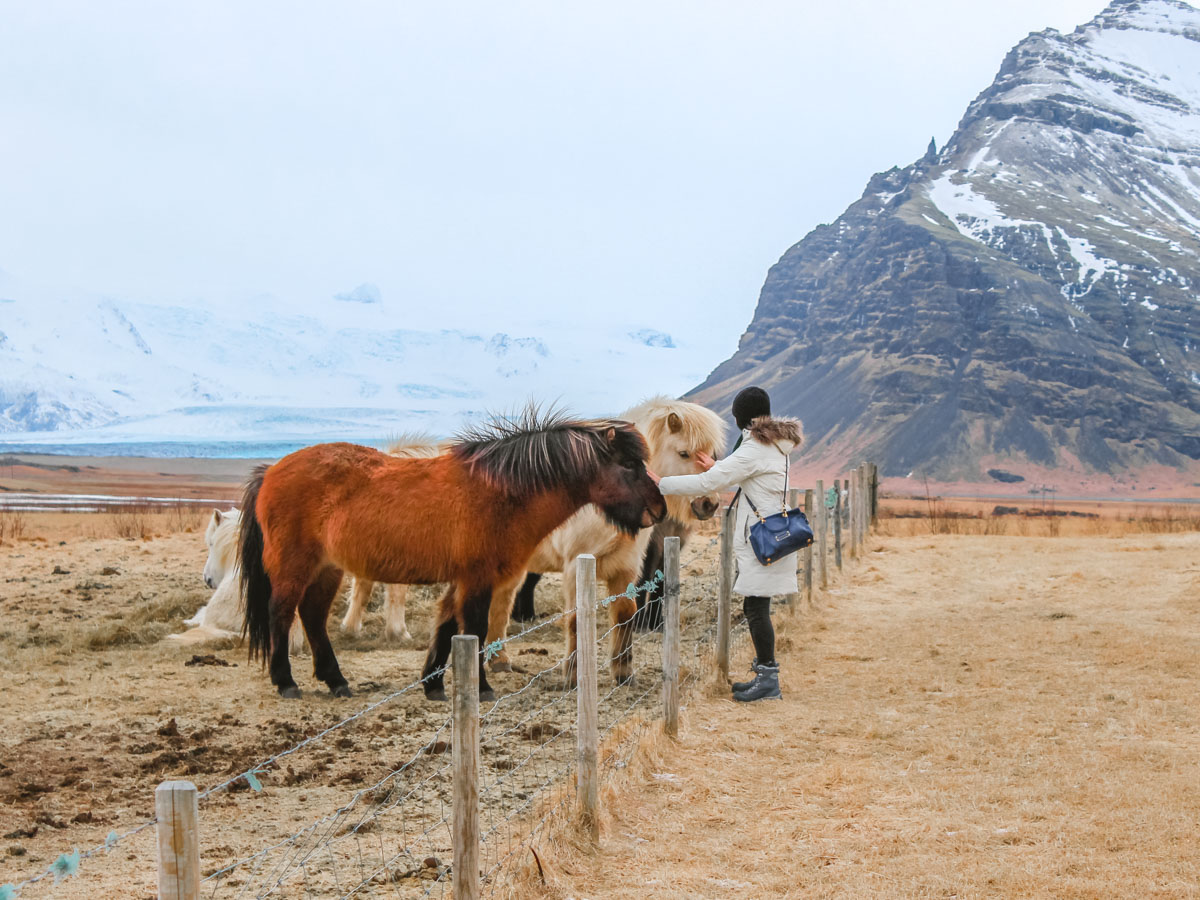
The horses were shorter than American horses, with thick winter fur and beautiful manes running across their face. These horses were extremely friendly, allowing us to pet them and following us as we walked along the fence. We felt so special, it was just the two of us enjoying this calm and peaceful moment with the horses.
As darkness fell we were hoping to see the Northern Lights again, but sadly the sky was covered with clouds. We couldn’t help but think that if we had arrived a day later, we would have missed the previous night’s show and may not get the chance to see the lights at all.
DAY 4: DIAMOND BEACH, JÖKULSÁRLÓN AND GLACIER HIKE
This was our last day of the tour. Our first stop on the way back to Reykjavík was Diamond Beach & Jökulsárlón, a glacier lagoon. Diamond Beach is a black sand beach right in front of the
Breiðamerkurjökull glacier. This beach has much calmer waves and is popular for giant, diamond-like ice blocks that are found all over the beach. Some of the glacial ice pieces are as tall and wide as a person. These large, blue blocks juxtaposed against the black sand makes for a striking photo and we saw dozens of photographers lined up with their tripods to capture the silky waves alongside the ice blocks.

We took a couple of shots of our own and then walked along the beach to find how these ice blocks landed on the sandy coast. At the southern end of the beach we found a stream with gigantic blocks of ice floating in it.
After following the ice blocks upstream, we arrived in front of a large lagoon formed by the retreating Breiðamerkurjökull glacier (an outlet glacier of the larger Vatnajökull glacier). The constant discharge of ice has resulted in a big glacial lagoon, Jökulsárlón, where one can see ice blocks of all shapes and sizes on their way to join the ocean. Standing here it is easy to understand how ships far into the ocean encounter these icebergs. Even only seeing the top of the icebergs they were huge, to think that 90% was still underwater is mind boggling. In the distance we could see some seals going in and out of the water, chillin’ on top of the floating ice. As beautiful as these icebergs are, it’s sad to think that these glaciers are receding and may one day vanish.
Leaving the lagoon it was time to see the glaciers up close on a glacier hike. We drove up to Svínafellsjökull glacier, part of the same glacier region. By the time we arrived, it had started to rain, but our guides were determined to get us out on the glacier. They quickly distributed helmets, crampons, and ice axes and soon we all left for the glacier like ducks following their mother. Out on the glacier we could see layers of ice for miles, unevenly structured with its own peaks and valleys, and at times making it hard to discern which direction we had come from. Our guides stopped us near a glacial hole to explain to us various features of the glacier and demonstrate self-arrest positions in the event someone lost their footing on the glacier. As we went further out onto the glacier, it started to snow, making it riskier to continue, so our hike got cut short and we headed back to the van. In a matter of minutes snow had covered the entire area, making it impossible to see the cracks or holes in the glacier. If we weren’t on a guided tour, we wouldn’t have been able to do something like this, at least not safely.
Very close to Svínafellsjökull glacier is Svartifoss, the waterfall that we most wanted to see, but something that we had to save for a future trip. Getting to this waterfall requires a 1-mile hike which is much harder to do in the winter due to heavy snowfall. The basalt formations around the upper part of the falls is iconic, we’ll surely visit the falls on our next trip when we come back to experience summer in Iceland.
Back in the warm van, we enjoyed a quiet ride back to Reykjavík, watching the glaciers, mountains, and the frozen landscape through the window, and even sneaking in a quick nap after such a long and eventful day.
DAY 5: REYKJAVÍK & WHALE WATCHING TOUR
In Reykjavík we stayed at the Room with a View apartment hotel. From our balcony we could see the early morning sun, a rare sight in the winters. The main agenda for the day was taking an airplane tour to fly over the Holuhraun volcano. The eruptions started in September 2014 and ended shortly after we left Iceland. Since we came at just the right time when the volcano was still active we decided we couldn’t pass up the chance to catch a glimpse of the lava.
In the middle of getting ready, we got a call from the airplane company that the weather in Holuhraun wasn’t good and they would have to cancel all morning flights but potentially could reschedule us for later in the day. We’d have to wait until the next weather report at noon to find out.
Given how sunny it was in Reykjavík, we were optimistic. We grabbed a quick breakfast at Tíu Dropar cafe and headed for the Sun Voyager again, eager to see what the view was like on a clear day. Across the water we could see the beautiful snow-peaked mountains all around Reykjavík, which was interesting since last time, under cloudy conditions, it didn’t appear like there was anything across the water at all.
With time on our hands, we thought it was the perfect time to tour the inside of Hallgrimskirkja. Having seen the basalt cliffs in Vik it was much easier to connect the design of the church with Icelandic nature. The church imitates the openness of Iceland with minimalistic design, all white walls, and large windows that let in ample light. On top of the entrance is an exquisite pipe organ with steel and wood finishing that stands out against the austere church walls. We certainly would have liked to see it in action. However, the biggest attraction of the church is the viewpoint on the top of the tower that can be accessed via an elevator for a nominal fee. From the top you can get an uninterrupted 360 view of the entire city, its colorful houses, the vast ocean, and the surrounding mountains. The side windows also provide a good angle of the “basalt” columns, descending in height just like a very steep staircase.
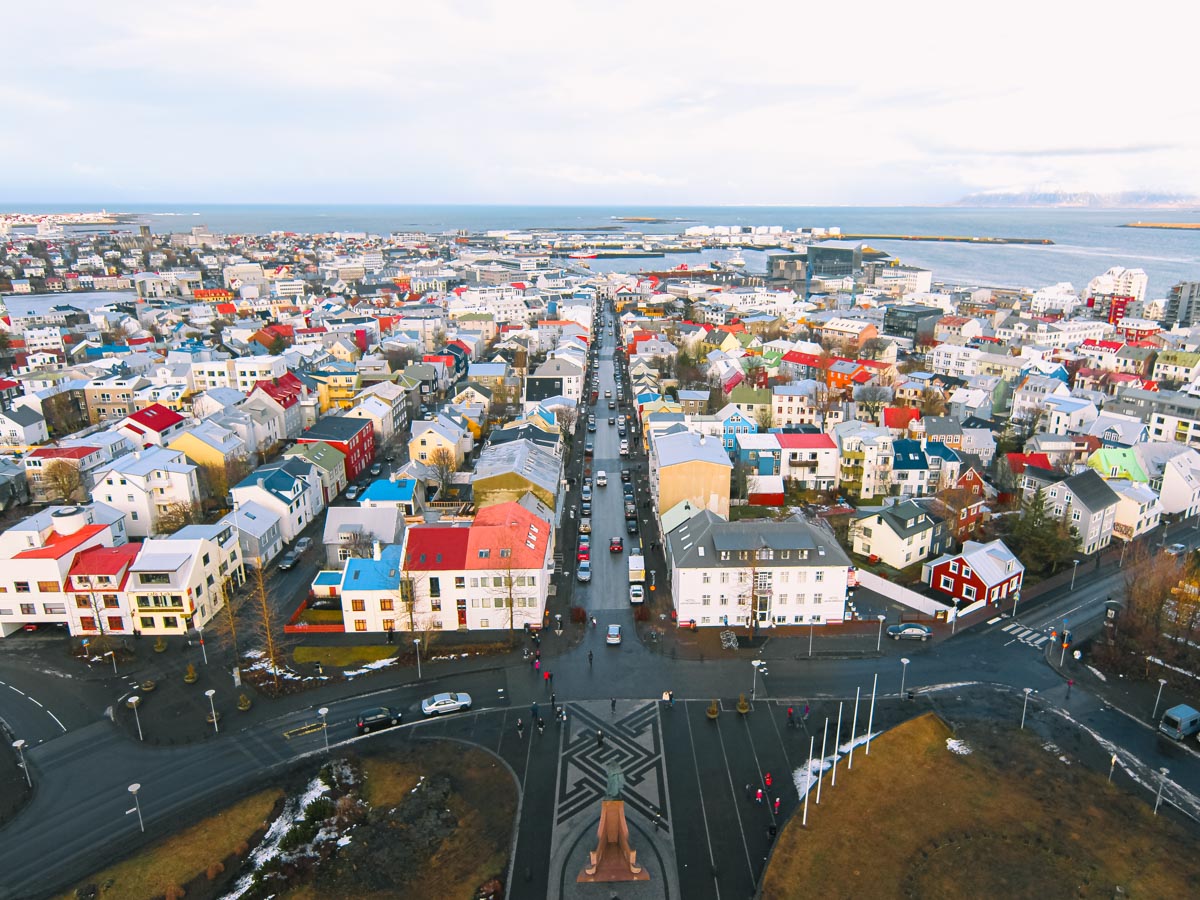
As we enjoyed the panoramic view of the city, we received another phone call from the airline company confirming that all flights over Holuhraun were cancelled due to inclement weather. We were pretty bummed since we had nothing else planned for the day. As we debated what else we could do we remembered seeing signs for afternoon whale watching tours. We wasted no time and rushed over to the main street (Laugavegur) to get the tickets. Luckily we were able to secure last minute tickets but now we had to make another run for the pier. With only 10 mins until departure, we sprinted across the town, arriving at the dock just in time. In hindsight, we should have gone to the pier directly to get the tickets.
Right as we got on the boat there were signs warning of rough sea conditions, but after fighting so hard to make the boat and not having any frame of reference for the water conditions, we thought how bad can it be? Well, after 20 minutes of enjoying the open view and going further out into the ocean, the water started to feel very choppy and we could feel the boat’s every rise and fall with the waves. It wasn’t a pleasant place to be. To escape the cold arctic winds we tried to hide inside, but the sea sickness got even more intense. So to make all the pain worth it, we stood on the deck all bundled up, right at the front of the ship, hoping to at least catch a glimpse of these magnificent creatures. We knew that the chances of seeing any whales were extremely slim at this time of the year but we were optimistic. Every now and then the captain would announce that the whales were spotted in that direction and we would head towards them, but these whales eluded us the entire trip. After 3 hours at sea, we returned to the pier, our heads still shaking and our limbs completely frozen. While we didn’t see any whales, we felt like we had gotten a legit arctic experience. Also since we didn’t see any whales our tickets were valid for another tour within the next year, unfortunately we didn’t have any other free days.
Back on land, we made a beeline for some hot coffee and warmth at Te & Kaffi. Later in the evening when we’d regained our strength and the nausea finally subsided, we treated ourselves to a nice dinner at Fiskmarkaðurinn (Fish market) to try the #1 rated sushi restaurant in Iceland.
DAY 6: GOLDEN CIRCLE TOUR
One of the most popular day trips from Reykjavík is the Golden circle tour, which includes Þingvellir National Park, the Gullfoss waterfall, and the geothermal area in Haukadalur, containing the geysers – Geysir and Strokkur. We booked our trip through Grayline, but there are plenty of companies that organize such tours. It is a full day tour, more true in the winters since the days are much shorter. Our day started at 8:30 AM before the sun was even up. We quickly realized how popular this tour was just based on how big the tour size was (~50 people), a huge contrast to our Southern Iceland tour.
Our first stop was the Hellisheiði Power Station, the third largest geothermal power station in the world. In addition to producing geothermal energy, the power station also runs an exhibition where we learned about sustainable energy and the role Hellisheiði plays in delivering clean energy to Reykjavík. After 30 mins we got back in the bus and drove to Skálholt, a historic site from the middle ages. The main attraction in Skálholt is the cathedral. The cathedral has beautiful stained glass windows and a unique mosaic altarpiece designed by Icelandic artist, Nína Tryggvadóttir.
After a short 45 minutes bus ride, we arrived at the first major stop on the tour, the Gullfoss waterfall. Gullfoss translates to “Golden falls”, named for when the sun shines down on the falls and the water emits a golden light. Gullfoss or Golden falls is also why this tour is popularly marketed as Golden Circle tour.
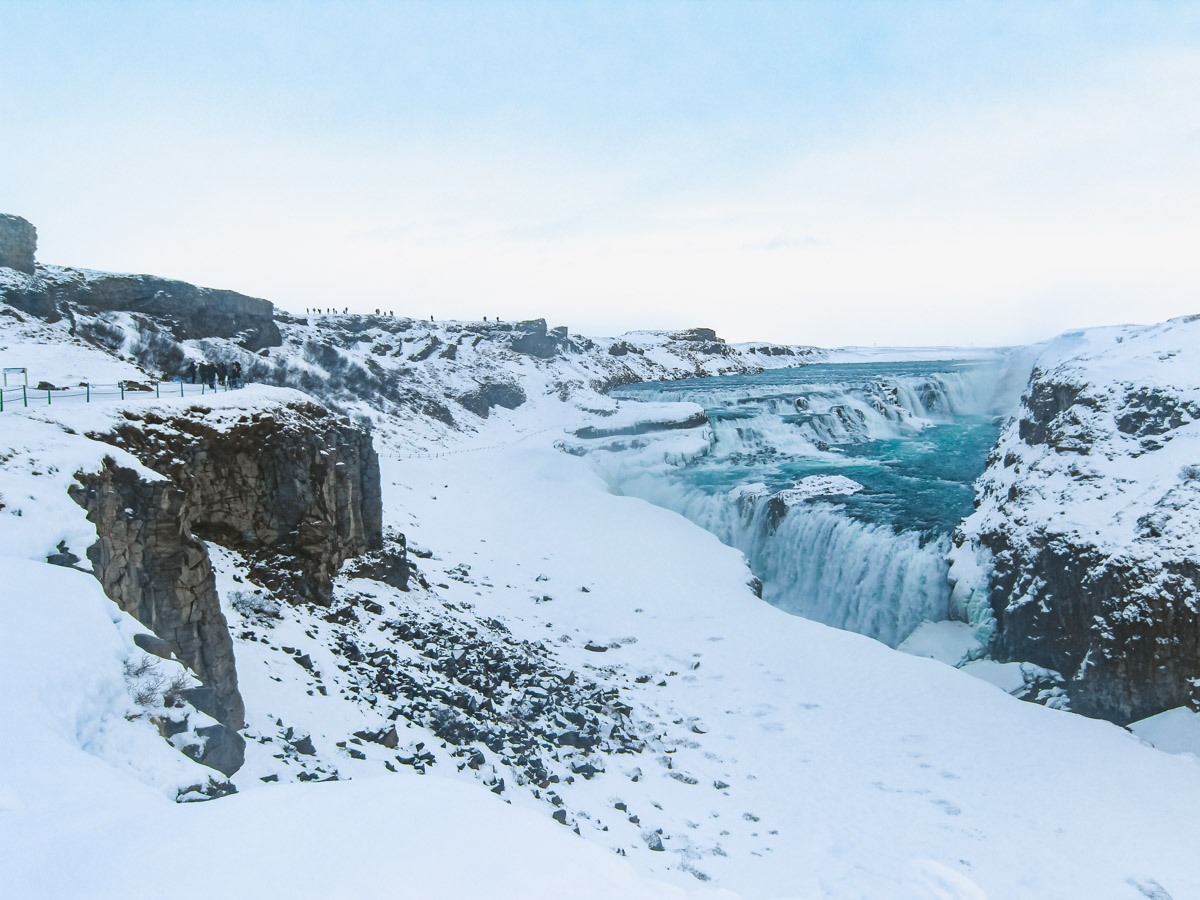
Gullfoss is different from the other waterfalls we had seen. Instead of a single fall, the waterfall drops in a series of steps before falling into the cataract. The falls, also can only be seen from above. While it’s hard to gage the height of the falls from that vantage point you can see how powerful the current is. With overcast freezing conditions, we certainly didn’t see the golden light and couldn’t stand too close to the falls for more than a few minutes because of the mist. After quickly taking some photos we rushed back inside Gullfoss Kaffi for a snack break.
Next stop on the tour was the geothermal fields in Haukadalur. This valley has a high concentration of hot springs, mud pots, and geysers. The most popular among them are Geysir (also where the English word was derived from) and Strokkur. Geysir is the bigger of the two and erupts to a height of 70m, but it has been inactive for years. Strokkur on the other hand erupts every 10-15 minutes. Watching it erupt certainly feels like a show, with crowds gathering and dispersing every 10 mins or so. The act starts off with water rising and falling in the geyser cone, followed by small eruptions, culminating in hot water and steam rising up to 30m. This was certainly the most interesting part of the tour for us.
Not far from the geothermal fields is the famous Þingvellir National Park. Þingvellir has high historic, cultural and geological importance. It is also a UNESCO site, as this is where the Althing (Icelandic parliament), first met in 938, with members representing all parts of Iceland. The park lies in the rift valley separating North American and Eurasian tectonic plates, making it one of the only places to observe the continental drift. One of the most popular activities in the park is to go diving in some of these submerged rifts but it wasn’t included on our tour.
From the parking lot we walked between the continental divide towards the visitor center occasionally stopping to take in the wide panoramic views. While we were there, the entire area was covered with snow and ice, hiding all the cracks and faults. Not aware of these cracks we carelessly walked over to the edge of the gorge, but thankfully a security guard called us back just in time. While we liked the open views of the park, we think this would have been much prettier in the summer, when the area wasn’t blanked in snow.
This was the last stop on the tour after which we drove back to Reykjavík. Surprisingly the weather cleared up, and we caught the only sunset on our trip from the hotel balcony. In the evening, we decided to visit Perlan, an iconic landmark built on top of hot water tanks, covered by a large glass dome. The attractions at Perlan include a planetarium, several exhibitions, an observation deck, and a restaurant. From the observation deck, we could see the glittering lights of the city and rising above them was the tower of Hallgrimskirkja. After a short wait we got a table at the restaurant, situated at one corner of the dome which revolves slowly as you dine. We definitely weren’t dressed for the place, but it didn’t matter. The ambience was perfect and while the food was also good, we think it could have been much better.
Back at the hotel as we prepared to sleep we saw a streak of green light through our windows. We went out onto the balcony, and indeed it was the Northern lights, although only faintly visible over the bright city lights. We checked the Aurora forecast and it was rated a high level of solar activity, so if we were outside of Reykjavík we could have seen the bright Northern Lights. It had already been a very long day for us, so we decided to just enjoy the lights from our balcony.
DAY 7: VOLCANO FLIGHT OVER HOLUHRAUN
We woke up to a beautiful clear day. Today we were going to try to fly over the lava fields at Holuhraun for the second time. Originally we had the day reserved for a geothermal spa at the Blue Lagoon, but we decided to save it for our last day and make it the final stop before the airport.
We started the day with a middle eastern breakfast at Kebabhúsið. With some time before the flight we spent the morning walking around the city and checking out souvenir stores on the main street (Laugavegur). One thing that caught our attention was the wool sweaters with an Icelandic pattern running across the top and around the neck. We decided to try it on and while it looked really nice, it was very itchy. Instead we opted for several small trinkets to commemorate our trip.
It was 12:00 PM and we still hadn’t heard back from the airplane company, so we decided to get drinks at the Laundromat Café. An ID check at the café prompted the discussion of what the legal drinking age is around the world, turns out kids can buy alcohol legally as early as 13 in some parts of the world. Our internet search was interrupted by a phone call, it was the airplane company. They mentioned that the weather in Holuhraun had just cleared up and asked us to come to the airport immediately. In a flash we finished our drinks and took a taxi over to the airport.
We booked our flight with Air Zafari, a very small company operating out of a small shared office building at the domestic airport. After signing the waivers, our pilot directed us to the aircraft Partenavia P.68, a 6-seater dual propeller plane registered to Copenhagen AirTaxi (CAT). There was another couple on the tour, so it was a fully booked flight. The engine turned on and the propeller blades were set in motion. It was finally happening.
As the plane took off, we got another look of the colorful houses, the Faxaflói Bay, and the surrounding mountains. We could also see the greater Reykjavík area, sparsely covered in snow. This soon changed as we left the city, the earthy colors of farms gave way to a monotonous white layer of snow. It truly was Ice-land. Every now and then, changes in surface elevation or snow texture variations would provide us hints as to what we were flying over, a mountain or a glacier, farms or river runoffs. This perhaps is the biggest disadvantage of visiting Iceland in the winters, the details and the earthy colors of the landscape are hidden beneath a blanket of snow.
65 mins into the flight, the snow on the ground started to clear exposing a dark, uneven, and barren landscape. We knew we were getting close. Soon enough we got the first glimpse of the volcano, with smoke rising up from the center. 6 months of continuous eruptions in the lava fields had given birth to a steep volcanic cone with a wide crater.
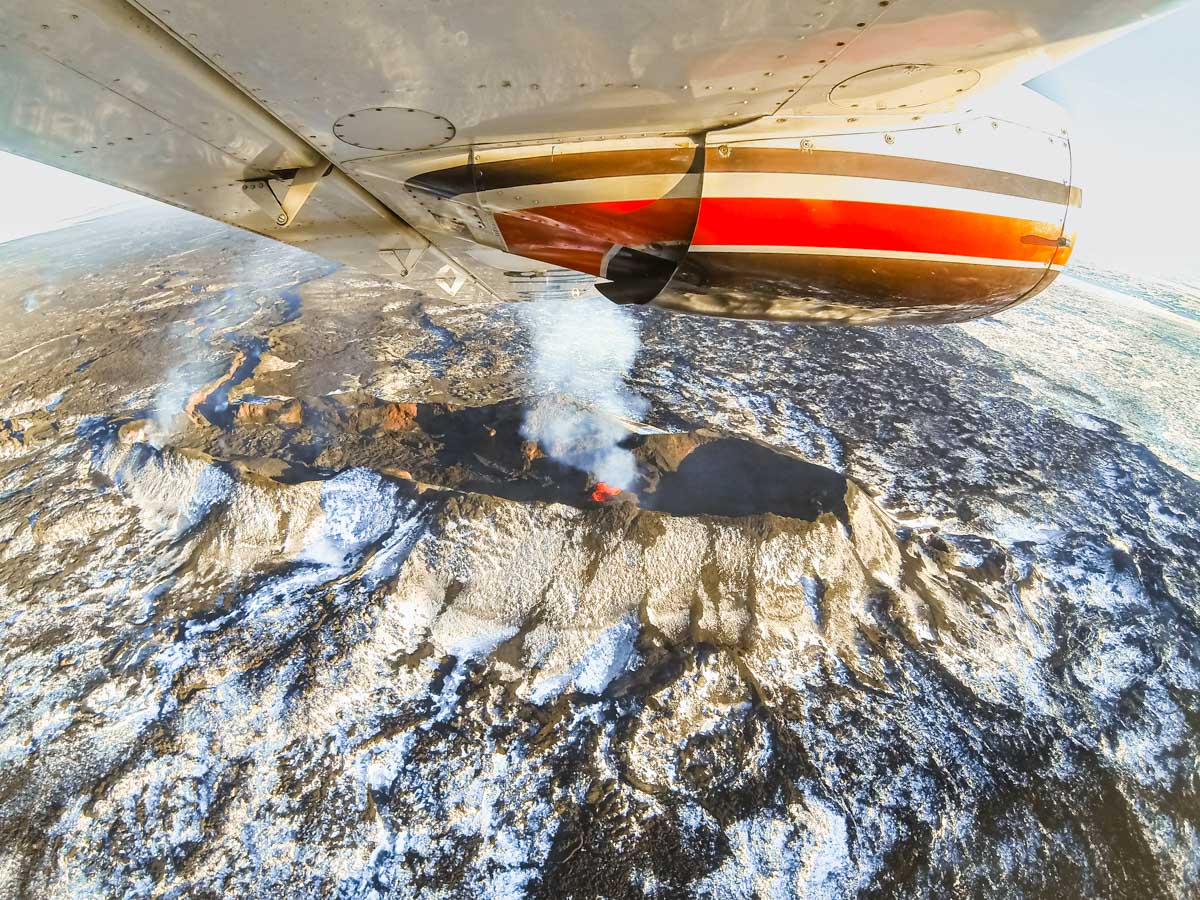
As we got closer to the rim, we saw a bright red pool of bubbling lava in its last stage of activity, the bright red color jumping out against the black hardened magma. While the lava wasn’t spewing up in the sky, it had continued to flow below the surface and we could see steam rising up all over the lava field. We circled the crater a couple of times so that everyone on the flight got a chance to see the lava pool from all angles. It felt like we were in a National Geographic documentary. From the volcano, we flew a bit over the rest of the lava fields and then made a wide 180 turn to return to Reykjavík. It was a surreal experience.
Nearing dinner time we thought it’d be fun to check out the local Indian food at Austurlandahraðlestin before heading out for rúntur, a weekend tradition that involves going from bars to bars into wee hours of the night. We started with a whiskey shot at the Dillon Whiskey bar, and then a white russian at the Lebowski Bar, followed by Kaldi, a dark icelandic beer at Kaffibarinn. Now it was 12:30 AM, it had started to snow and switching bars was getting much harder. Since it was our last night, we kept going. Looking for our next stop we suddenly heard Alicia Keys – New York “Empire State of Mind” playing in a club, it was a sign that we had to go in. As we approached the bouncers, they stopped us citing we didn’t meet the dress code. We needed dinner jackets and dancing shoes, but instead had snow boots and winter jackets on. We hadn’t prepared for a dressy warm winter outfit for the occasion. We continued on and made it into B5, a night club in Bankastræti. With our Brennivín cocktails in hand, we joined others on the dance floor. Here we were reunited with fellow travelers from the Extreme Iceland tour group. From B5 we all moved onto Austur for more Reyka cocktails and shots of Opal, finally ending our night at The English Pub, where we befriended a group of locals who offered us more shots and drinks.
When we left, people were still lining up, but it was late and we were ready to hit the bed.
DAY 8: BLUE LAGOON
This was our last day in Iceland. We woke up with only 3 hours of sleep. Still half asleep, we packed the rest of our belongings for the flight back. But instead of directly going to the airport we decided to stop at the renowned Blue lagoon for a geothermal spa, a common plan for many travelers since the spa is so close to the airport. We booked two shuttles, one from our hotel to Blue Lagoon and then from Blue Lagoon to Keflavík Airport.
Blue Lagoon is man-made and the water is fed by the nearby geothermal power plant Svartsengi. Blue lagoon offers a lot of facilities, including a hotel, luxury spa, and a restaurant. We bought the Blue Lagoon day pass which includes access to the pool, silica mud mask, a drink and a towel. We took a change of clothes and left the rest of our luggage in the storage – anticipating a lot of people coming from and going to the airport, the storage was easy even with all of our luggage.
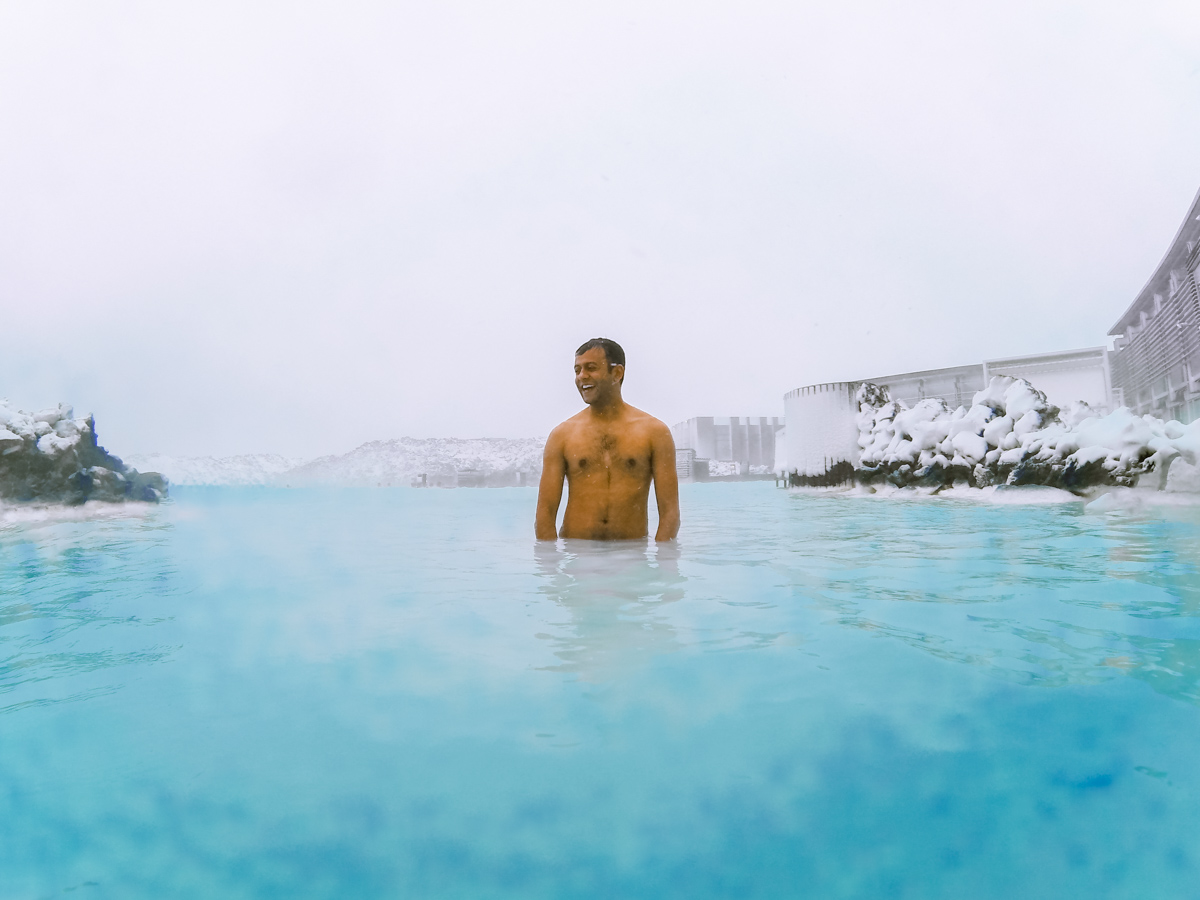
After a quick shower, we entered the milky blue pools of the lagoon. The blue color comes from high silica content in the water, which can also be observed on the sides of the pool where silica deposits as soft wide mud. As we left the building, we were hit by strong, cold winds. There was a blizzard on the day we were there, so while our lower body was warm, our face and ears were completely frozen. It couldn’t be a more contrasting experience. As the snow and winds continued to blow, we bobbed in and out of the water to keep our bodies warm. The water also smelled of sulphur but after a few days in Iceland it didn’t bother us much. We finished off our spa experience by rubbing some of that silica mud on our skin and then it was time to shower and leave for the airport. A geothermal spa in a blizzard was a perfect way to end our trip.
ADDENDUM: FIASCO AT THE AIRPORT
At the airport we checked our bags, got our boarding passes, and then queued up for immigration. Kelsey went up to the counter, got her exit stamp, and entered the departure area. Kaushal followed behind with his Nepalese passport but at the immigration counter the officer asked for his Canadian visa. Since our final destination was the US not Canada, he replied that he didn;t need a Canadian visa and that the US one was inside the passport.. She replied that since Canada was his layover he would also need a Canadian visa. That didn’t seem right, the layovers we had done in multiple other countries had never required a visa for a layover. Kaushal tried to explain this and the fact that we’d be in Canada for less than 2 hours with no intentions of leaving the airport. She seemed annoyed that his paperwork was not in order and asked him to step out of the line. Panic set in.
Now Kaushal had no way to get home and on top of that he had to figure out how to leave the EU that day since his Schengen visa was going to expire the very next day. Extending his stay past the expiration date would lead to more problems, like not being able to enter the EU for 2 years and jeopardizing future visa applications. So there was definitely some urgency to finding a plan B for leaving Iceland.
Kaushal went to the IcelandAir help desk and explained his situation to them, hoping that they could either rebook him on a direct flight to the US or ANY other place in the world where he could enter legally, which is a pretty short list for Nepalese citizens. Lucky for him, not only was there a direct flight to New York that day but it had the last available seat. IcelandAir graciously rebooked the tickets at no extra charge. Unfortunately they couldn’t do the same for Kelsey, so that meant we’d be on different flights home. We made peace with it, just glad no visas would be violated, and headed to our individual flights.
Kaushal arrived in New York around the time when Kelsey landed in Toronto for her connection. While Kelsey had flown IcelandAir to Canada, she would be switching to Air Canada for the second leg of the trip. This meant she needed to pick up the checked baggage, go to the check in counter for her boarding pass, and recheck the bags with Air Canada. As Kaushal arrived back home, he got a call from Kelsey who said the bags hadn’t arrived and that she didn’t know what to do. She had already waited a long time for the last bag and now with only 45 mins left for the connecting flight, she had to rush but didn’t know what would happen to the bags if they were left abandoned in Canada. Somewhat uncertain, she decided the bags must not be coming and made her way to the ticket counter to at least get her boarding pass.
Her problems were far from over. At the counter when she tried to check in she was informed that she had arrived too late so they couldn’t issue her a boarding pass. Exhausted from all of Kaushal’s flight drama, she just wanted to get home, she pleaded with the attendants for any flight that would take her to the New York area. After they scanned the systems they said they could put her on standby, but could make no promises. Glad that she was on at least some list, she made it through security and went to wait at the gate. Only then after finally taking a breather she glanced down at the ticket and realized they had printed someone else’s name, it was the same surname but a totally different first name.
Panicking herself, and looking for someone to correct it, she couldn’t find any Air Canada reps as the flight wasn’t for a few more hours. She nervously waited, wondering if her standby request would still be valid under someone else’s name, but just had to wait and keep a lookout for someone who could help. Listening to all of this on the phone, Kaushal couldn’t understand what was going on. We lost our baggage, Kelsey’s flight got cancelled, she had a boarding pass on somebody else’s name. All he wanted was for her to come back home. As the boarding time got closer, things began to sort themselves out, her ticket was corrected, she was given an actual seat, and it looked like the plane, while delayed, was going to fly. In the wee hours of the night she finally made it back home, entirely exhausted from all of the drama she’d just lived through.
The next day we called up IcelandAir to try to recover our checked luggage and that’s when we found out they had taken ourbags off the aircraft in Reykjavík since both bags were registered under Kaushal’s name and he hadn’t boarded his original flight. We weren’t aware of this policy, you fly and learn. We gave our address to IcelandAir and they said they’d ship it to us later that week. We were relieved our stuff was not gone forever.
This experience taught us some valuable lessons. First and foremost, always check visa eligibility not only for the destination but also for the transit points. Second, try to book direct flights if the price difference isn’t that much. Lastly, err on the side of not checking in your bags, if Kelsey hadn’t waited for them at the luggage carousel she may have made her original connection home.
